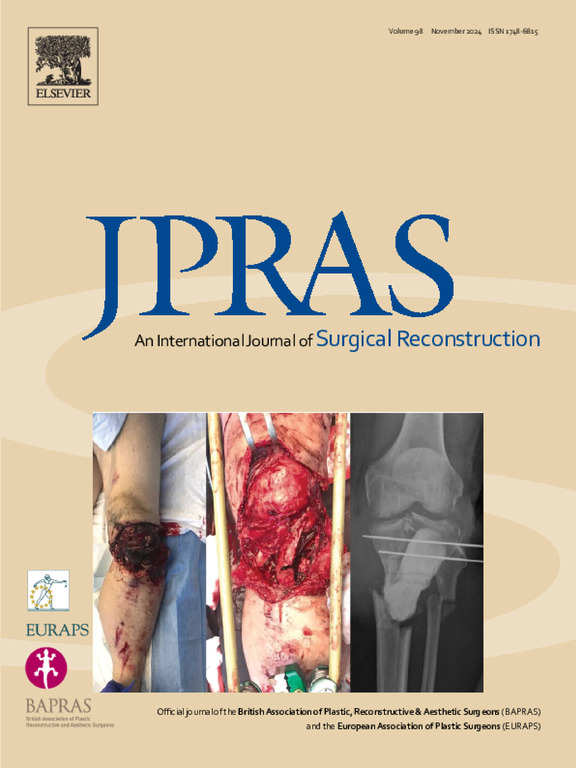比较下肢皮肤癌患者腹股沟淋巴结切除术与腹股沟-骨盆淋巴结切除术的腿部体积比。
IF 2
3区 医学
Q2 SURGERY
Journal of Plastic Reconstructive and Aesthetic Surgery
Pub Date : 2024-10-11
DOI:10.1016/j.bjps.2024.10.003
引用次数: 0
摘要
背景:不同机构治疗淋巴水肿的干预时机各不相同。了解不同淋巴结切除手术后淋巴水肿发生率和严重程度的差异,可促进早期干预治疗淋巴水肿。目前几乎没有证据支持腹股沟盆腔淋巴结切除术的发病率高于腹股沟淋巴结切除术的观点,尽管人们认为手术范围的不同会导致淋巴水肿严重程度的不同。在这项研究中,我们比较了下肢皮肤癌患者腹股沟淋巴结切除术和腹股沟盆腔淋巴结切除术的体积百分比变化:共29名接受淋巴结切除术的下肢皮肤癌患者被分为腹股沟淋巴结切除术组和腹股沟-骨盆淋巴结切除术组。通过容积渲染计算机断层扫描图像计算整个下肢、大腿和小腿受累侧与未受累侧相比的容积增加情况:结果:腹股沟淋巴结切除术组和腹股沟盆腔淋巴结切除术组整个下肢的平均体积增加百分比分别为 6.72% 和 11.18%,小腿的平均体积增加百分比分别为 7.30% 和 2.55%,差异无统计学意义。相比之下,两组患者大腿的平均体积百分比增幅分别为 7.03% 和 19.78%,差异有统计学意义(p = 0.0275 < 0.05):本研究结果表明,与腹股沟淋巴结切除术相比,整个下肢的腿部体积可能不会带来更差的结果。本文章由计算机程序翻译,如有差异,请以英文原文为准。
Comparison of leg volume ratio between inguinal lymphadenectomy and inguino-pelvic lymphadenectomy in patients with skin cancer of the lower extremity
Background
The timing of intervention to treat lymphedema differs among facilities. Understanding differences in the prevalence and severity of lymphedema following different surgical procedures for lymphadenectomy could promote early intervention to treat lymphedema. There is currently little evidence to support the notion that inguino-pelvic lymphadenectomy is associated with greater morbidity than inguinal lymphadenectomy, although it is believed that the difference in the extent of surgery results in a difference in the severity of lymphedema. In this study, we compared volume percentage change between inguinal lymphadenectomy and inguino-pelvic lymphadenectomy in patients with skin cancer of the lower extremity.
Patients and methods
A total of 29 patients with skin cancer of a lower extremity who underwent lymphadenectomy were classified into an inguinal lymphadenectomy group and an inguino-pelvic lymphadenectomy group. The increase in the volume of the affected side compared with that of the unaffected side in the whole lower extremity, thigh, and lower leg was calculated on volume-rendered computed tomography images.
Results
The mean volume percentage increase in the inguinal lymphadenectomy group and the inguino-pelvic lymphadenectomy group was, respectively, 6.72% and 11.18% in the whole lower extremity and 7.30% and 2.55% in the lower leg, showing no statistically significant differences. In contrast, the mean volume percentage increase in the respective groups was 7.03% and 19.78% in the thigh, showing a statistically significant difference (p = 0.0275 < 0.05).
Conclusions
The findings of this study indicate that the leg volume of the whole lower extremity may not have worse outcomes in inguino-pelvic lymphadenectomy compared with inguinal lymphadenectomy.
求助全文
通过发布文献求助,成功后即可免费获取论文全文。
去求助
来源期刊
CiteScore
3.10
自引率
11.10%
发文量
578
审稿时长
3.5 months
期刊介绍:
JPRAS An International Journal of Surgical Reconstruction is one of the world''s leading international journals, covering all the reconstructive and aesthetic aspects of plastic surgery.
The journal presents the latest surgical procedures with audit and outcome studies of new and established techniques in plastic surgery including: cleft lip and palate and other heads and neck surgery, hand surgery, lower limb trauma, burns, skin cancer, breast surgery and aesthetic surgery.

 求助内容:
求助内容: 应助结果提醒方式:
应助结果提醒方式:


